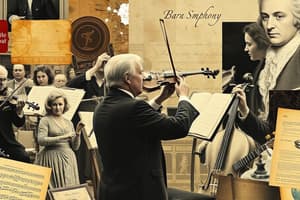Podcast
Questions and Answers
The heart of the Classical orchestra was the string family.
The heart of the Classical orchestra was the string family.
True (A)
Who was the composer of the London Symphonies?
Who was the composer of the London Symphonies?
Joseph Haydn
Haydn's Symphony No. 100 was first presented in _____. Its nickname comes from the use of percussion instruments associated with _________ military music.
Haydn's Symphony No. 100 was first presented in _____. Its nickname comes from the use of percussion instruments associated with _________ military music.
London; Turkish
What nationality are Janissary bands?
What nationality are Janissary bands?
Which of the following musical elements did the German Classical symphonists contribute to the symphony genre?
Which of the following musical elements did the German Classical symphonists contribute to the symphony genre?
What meter does Haydn use in the second movement of his Symphony No. 100 to emulate a march?
What meter does Haydn use in the second movement of his Symphony No. 100 to emulate a march?
How many instrument families were present in the Classical-era orchestra?
How many instrument families were present in the Classical-era orchestra?
How many movements does Haydn's Symphony No. 100 have?
How many movements does Haydn's Symphony No. 100 have?
How is the melody of Haydn's Symphony No. 100 characterized?
How is the melody of Haydn's Symphony No. 100 characterized?
What is the rhythm/meter of Haydn's Symphony No. 100?
What is the rhythm/meter of Haydn's Symphony No. 100?
Describe the harmony in Haydn's Symphony No. 100.
Describe the harmony in Haydn's Symphony No. 100.
What is the texture of Haydn's Symphony No. 100?
What is the texture of Haydn's Symphony No. 100?
What is the form of the second movement in Haydn's Symphony No. 100?
What is the form of the second movement in Haydn's Symphony No. 100?
What expression characteristic is found in Haydn's Symphony No. 100?
What expression characteristic is found in Haydn's Symphony No. 100?
What performing forces were utilized in Haydn's Symphony No. 100?
What performing forces were utilized in Haydn's Symphony No. 100?
From which older genre did the symphony evolve?
From which older genre did the symphony evolve?
Haydn's Symphony No. 100 was not well received by the British public.
Haydn's Symphony No. 100 was not well received by the British public.
Which of the following describes Haydn's role in the development of the Classical-era symphony?
Which of the following describes Haydn's role in the development of the Classical-era symphony?
In Haydn's Symphony No. 100, which instruments were utilized to emulate 'Turkish' musical sounds?
In Haydn's Symphony No. 100, which instruments were utilized to emulate 'Turkish' musical sounds?
What is the nickname of Haydn's Symphony No. 100?
What is the nickname of Haydn's Symphony No. 100?
Which of the following are characteristics of the second movement of Haydn's Military Symphony?
Which of the following are characteristics of the second movement of Haydn's Military Symphony?
Percussion is absent from the second movement of Haydn's Symphony No. 100.
Percussion is absent from the second movement of Haydn's Symphony No. 100.
The Classical orchestra typically included how many players?
The Classical orchestra typically included how many players?
The form of the second movement in Haydn's Symphony No. 100 is in how many parts?
The form of the second movement in Haydn's Symphony No. 100 is in how many parts?
What is the name for a Classical theme that quickly ascends from a low register to a high register?
What is the name for a Classical theme that quickly ascends from a low register to a high register?
Flashcards are hidden until you start studying
Study Notes
Classical Orchestra and Symphony
- The string family served as the core component of the Classical orchestra.
- Joseph Haydn composed the renowned London Symphonies.
- Haydn's Symphony No. 100, nicknamed "Military," debuted in London and features percussion reminiscent of Turkish military music.
Cultural Influences and Genres
- Janissary bands are of Turkish origin.
- The Classical symphony genre was influenced by the Italian opera overture.
Contributions to Symphony Development
- German Classical symphonists introduced musical elements like the "rocket theme" and "steamroller" effect.
- Haydn is credited as the "father of the symphony," having composed approximately 100 symphonies including 12 intended for London audiences.
Structure and Composition of Symphony No. 100
- Symphony No. 100 consists of two main movements:
- I. Adagio-Allegro in sonata-allegro form, G major.
- II. Allegretto in A-B-A' form, C major.
- The melody is characterized by a simple, graceful theme organized in regular phrases.
- Regular duple meter is utilized to evoke a march-like quality in the second movement.
Musical Elements in Symphony No. 100
- Harmonic progression shifts from C major to C minor and back to C major.
- Texture of the symphony is homophonic.
- The second movement exhibits sudden dynamic contrasts and is structured in three parts.
- The large orchestra includes woodwinds, trumpets, French horns, and various percussion instruments.
Reception and Impact
- Haydn's Symphony No. 100 initially faced criticism and was not well received by the British public.
- Instruments like cymbals and triangles were included to imitate Turkish musical sounds, contributing to its "military" nickname.
- The typical Classical orchestra encompassed 30 to 40 players, showcasing a blend of instrument families: strings, woodwinds, brass, and percussion.
Notable Features
- The second movement features key characteristics such as a duple meter and a simple, graceful theme while notably lacking percussion instruments.
Studying That Suits You
Use AI to generate personalized quizzes and flashcards to suit your learning preferences.




